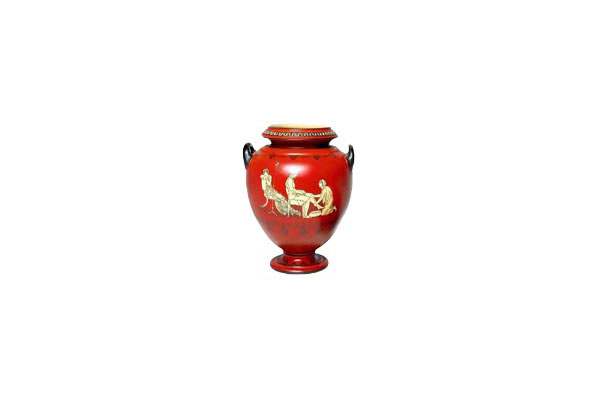The brick reds, glossy black and pale yellows found in the Roseville Olympic line suggests a Greek approach from the artist. It’s a striking line, most of which have those deep glosses that really allow them to stand out. But if indeed believe the early 1900 line is simply a Greek influence, you might want to rethink that.
 In fact, John Flaxman, another well known artist of his time, mostly for his Neo-Classical designs, was the true inspiration. Some say the images are absolute efforts of reproductions. And going even further back before Flaxman, the argument’s been made that Homer’s The Iliad and The Odyssey – both tragedies – was the foundation of the inspiration.
In fact, John Flaxman, another well known artist of his time, mostly for his Neo-Classical designs, was the true inspiration. Some say the images are absolute efforts of reproductions. And going even further back before Flaxman, the argument’s been made that Homer’s The Iliad and The Odyssey – both tragedies – was the foundation of the inspiration.
The pieces themselves are modeled after the Roseville Creamware; the red pigments were applied over the bodies, careful to camouflage any similarity to the Creamware line. From there, decorators were tasked with transferring the reproduced lines to the bodies, and from there, the artists completed the final look.
And here’s another interesting element: Olympic wasn’t the only line that drew its inspiration from Flaxman. Both Della Robbia and Old Ivory have remarkable similarities, even if they’re not as obvious as those in the Olympic line.
Most of the Olympic pieces were marked with “Rozane Pottery” and were the last of these striking Roseville Pottery designs that defined Rozane.
This particular line is also one of the more expensive lines. The color combinations are rich and generous as they drape the various vessels. There’s a lot of detailing in this line, too. Often, you’ll discover intricate pattern décor along the baselines, necks or even right inside the design. It really is a beautiful line to collect.
As mentioned, this line was introduced in the early 1900s and was instantly popular in those early days. Even by today’s standards, this line presents as quite contemporary and is as popular today as it was then.


